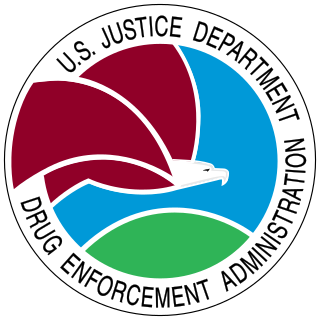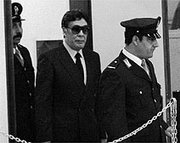This article relies too much on references to primary sources . (Learn how and when to remove this template message) |
| Hampton v. United States | |
|---|---|
 | |
| Argued December 1, 1975 Decided April 27, 1976 | |
| Full case name | Hampton, a/k/a Byers v. United States |
| Citations | 425 U.S. 484 ( more ) 96 S. Ct. 1646; 48 L. Ed. 2d 113; 1976 U.S. LEXIS 49 |
| Case history | |
| Prior | Defendant convicted of violating 21 U.S.C. § 841(a) in United States District Court for the Eastern District of Missouri; conviction affirmed, 507 F.2d 832 (8th Cir. 1974); cert. granted, 420 U.S. 1003(1975). |
| Subsequent | Conviction affirmed |
| Holding | |
| Government agents supplying illegal drugs for transaction does not constitute entrapment where defendant had predisposition to sell drugs regardless of supplier. | |
| Court membership | |
| |
| Case opinions | |
| Majority | Rehnquist, joined by Burger, White |
| Concurrence | Powell, joined by Blackmun |
| Dissent | Brennan, joined by Stewart, Marshall |
| Stevens took no part in the consideration or decision of the case. | |
| Laws applied | |
| Existing entrapment case law | |
Hampton v. United States, 425 U.S. 484 (1976), is a United States Supreme Court decision on the subject of Entrapment. By a 5-3 margin, the Court upheld the conviction of a Missouri man for selling heroin even though all the drug sold was supplied to him, he claimed, by a Drug Enforcement Administration informant who had, in turn, gotten it from the DEA. The majority held that the record showed Hampton was predisposed to sell drugs no matter his source. [1]
In criminal law, entrapment is a practice whereby a law enforcement agent or agent of the state induces a person to commit a criminal offense that the person would have otherwise been unlikely or unwilling to commit. It "is the conception and planning of an offense by an officer or agent, and the procurement of its commission by one who would not have perpetrated it except for the trickery, persuasion or fraud of the officer or state agent."

Missouri is a state in the Midwestern United States. With over six million residents, it is the 18th-most populous state of the Union. The largest urban areas are St. Louis, Kansas City, Springfield, and Columbia; the capital is Jefferson City. The state is the 21st-most extensive in area. Missouri is bordered by eight states : Iowa to the north, Illinois, Kentucky, and Tennessee to the east, Arkansas to the south, and Oklahoma, Kansas, and Nebraska to the west. In the South are the Ozarks, a forested highland, providing timber, minerals, and recreation. The Missouri River, after which the state is named, flows through the center of the state into the Mississippi River, which makes up Missouri's eastern border.

Heroin, also known as diamorphine among other names, is an opioid most commonly used as a recreational drug for its euphoric effects. It is used medically in several countries to relieve pain or in opioid replacement therapy. It is typically injected, usually into a vein, but it can also be smoked, snorted, or inhaled. The onset of effects is usually rapid and lasts for a few hours.
Contents
- Background of the case
- Lower courts
- Trial
- Appeal
- Supreme Court case
- Decision
- Subsequent jurisprudence
- See also
- References
- External links
The case came before the court when the defendant argued that while he was predisposed, it was irrelevant since the government's possible role as sole supplier in the case constituted the sort of "outrageous government conduct" that Justice William Rehnquist had speculated could lead to the reversal of a conviction in the court's last entrapment case, United States v. Russell . [2] Rehnquist was not impressed and rejected the argument in his majority opinion.

William Hubbs Rehnquist was an American jurist and lawyer who served on the Supreme Court of the United States for 33 years, first as an Associate Justice from 1972 to 1986, and then as the 16th Chief Justice of the United States from 1986 until his death in 2005. Considered a conservative, Rehnquist favored a conception of federalism that emphasized the Tenth Amendment's reservation of powers to the states. Under this view of federalism, the court, for the first time since the 1930s, struck down an act of Congress as exceeding its power under the Commerce Clause.
United States v. Russell, 411 U.S. 423 (1973), is the latest Supreme Court case dealing with the entrapment defense. The court split 5-4 and maintained the subjective theory that had first been adopted in Sorrells v. United States, 287 U.S. 435 (1932). Although an undercover federal agent had helped procure a key ingredient for an illegal methamphetamine manufacturing operation, and assisted in the process, the Court followed its earlier rulings on the subject and found that the defendant had a predisposition to make and sell illegal drugs whether he worked with the government or not.
The dissents agreed that the government's purported action was outrageous and that the conviction should be overturned on those grounds. The justices were among those who had said in Russell that the "subjective" entrapment standard adopted by the Court since it first recognized entrapment as a valid defense in Sorrells v. United States , [3] was less fair and appropriate than the "objective" standard of evaluating official conduct, which dissents and concurrences in entrapment cases over the years had argued for. However, this was the last entrapment case to feature that conflict.
Sorrells v. United States, 287 U.S. 435 (1932), is a Supreme Court case in which the justices unanimously recognized the entrapment defense. However, while the majority opinion by Chief Justice Charles Evans Hughes located the key to entrapment in the defendant's predisposition or lack thereof to commit the crime, Owen Josephus Roberts' concurring opinion proposed instead that it be rooted in an analysis of the conduct of the law enforcement agents making the arrest. Although the Court has stuck with predisposition, the dispute has hung over entrapment jurisprudence ever since.

